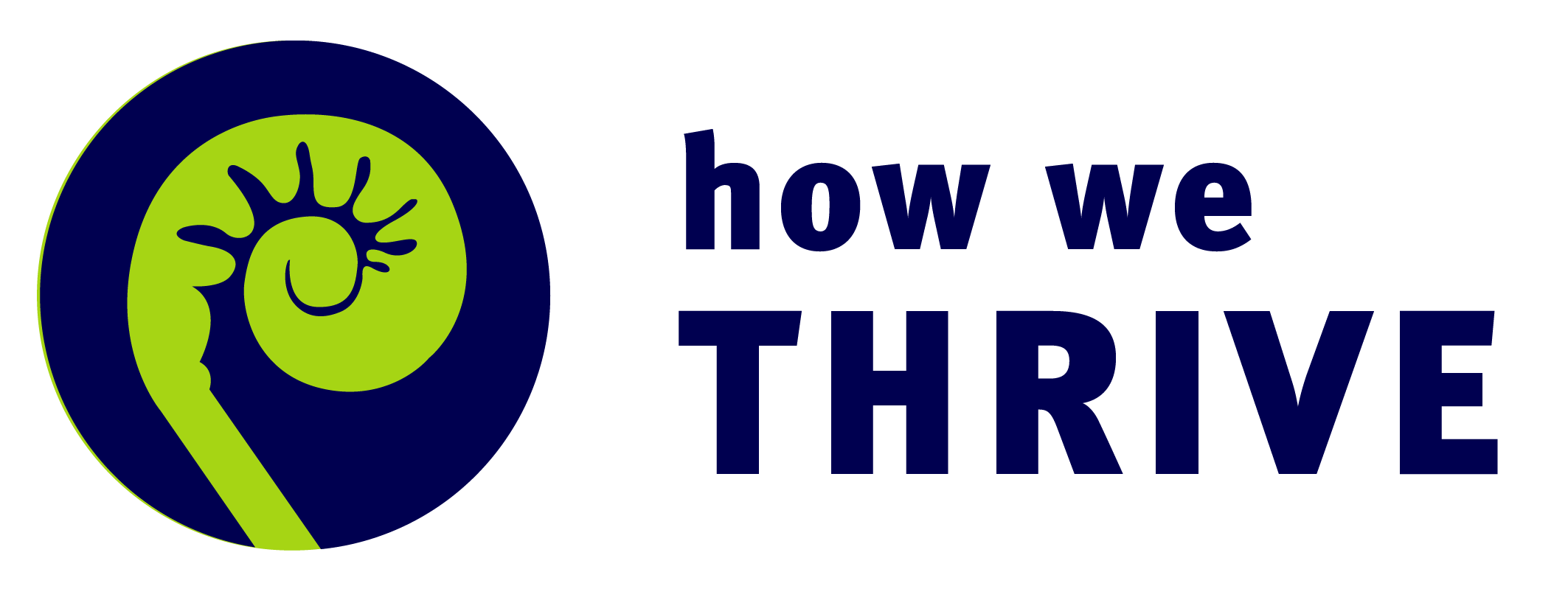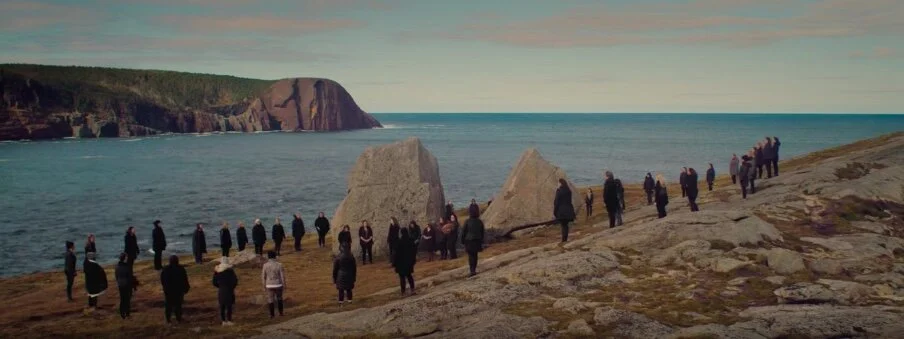Nourished by these stories
by Susan Szpakowski
"A people are as healthy and confident as the stories they tell themselves…. Even in silence we are living our stories."
—Nigerian novelist and poet Ben Okri
Take me to a moment…
A story well told draws me into your experience. We see, touch, feel something together. You are no longer a stranger. New understanding, possibilities and commitments are born in this space of story-sharing.
The Narrative Project took shape early in 2020, as a partnership between How We Thrive and WeavEast. But my own commitment to this project can be traced back to a moment that touched me deeply, in June 2018.
It was at the first Thrive gathering, in a learning stream led by Chené Swart and Sobaz Benjamin, called “Shaping Our Future Through Stories.” Also in the stream were several Gaelic-speaking women from Cape Breton/ Unama’ki, several women from We'koqma'q First Nation, and others from the African Nova Scotian and newcomer communities. Chené led us through story-sharing exercises that quickly developed a sense of intimacy in the room.
As the stream was drawing to a close, we shared appreciation for our time together. A young Gaelic woman, Amber Buchanan, walked over to Ma’git Poulette, an Elder from We'koqma'q, holding a piece of coloured cloth. Amber said, “Knowing I was coming here and that I would meet my Mi’kmaw neighbours, I spun some yarn and wove this cloth in the five colours of the Medicine Wheel. I felt ashamed that I had grown up just down the road from your community but never really met any of these neighbours. I wanted to express my gratitude for having this chance to be together here, and to offer you this gift.”
I am moved even as I write this now. That moment was a gift to us all. Looking back, I realize that my passion about narrative was fueled by a desire for more moments like this one. I was willing to commit time and energy to learning more about how such moments happen, what conditions are needed. Because heaven knows we need more stories that acknowledge and begin to heal colonial wounds. Our current pandemic is a surface expression of deeper troubles that plague our world.
Chené Swart returned to Thrive the following year, and she became an advisor for The Narrative Project. We are now experimenting with “reauthoring” practices she developed, which take narrative out of the realm of marketing, politics, and the promotion of products and ideas, and back into the hands and authorship of people whose stories arise from their own lived experience.
I expect each person on our team has had moments that brought them to our circle and that continue to inspire the themes they choose. Over the spring and fall we took turns, sometimes in pairs, inviting guests and hosting 90-minute online sessions.
Grounded in place, arising in relationship
Andrea Currie and Elder Albert Marshall opened our first session, reminding us of our interconnectedness and responsibility to the land and each other, including future generations. Together we are listening for narratives arising in the place we call Atlantic Canada, the ancestral land and unceded territory of the Mi'kmaq, Maliseet, Innu and Inuit.
Each session included guest speakers and a chance to connect and make meaning together in small groups. We were amazed at how far we were able to go in a virtual space with mostly strangers. In feedback surveys, people told us how much they valued the connections they made in these break-out groups.
In one session hosted by Maggie Burton, “Together We Stand,” our featured guests shared the story of two singing groups in Newfoundland and Labrador coming together to create a powerful music video about violence against women. One of these groups was the Indigenous-led women’s drum group Eastern Owl and the other a professional women’s choir, Lady Cove.
The guests talked about how critical it had been to build their relationship over time, gradually mixing their musical cultures until something strong and new emerged. They said it was not always easy to take the time for relationship-building in the midst of project and funding timelines, but it had been necessary. In the video, their voices draw power from the rocks they stand on, the ocean, their circle, and the harmony of voice and drum. Watch it here.
Inviting magic
Our team plans and prepares for each session, but with a light touch and just in time. We are trying to follow the lead of fresh narrative opportunities. As each person on our team steps forward to host, I am amazed to see how things come together and fall apart and come together again, often up until the last minute...and sometimes even after that minute. Tara Taylor invited three guests to join her session “Arts as Medicine,” but when the session started only one was present. She was going to sing “Count on Me” with a colleague but instead sang solo, and it was beautiful. Like a true artist, she just kept rolling with what was happening, not what was supposed to be.
That session took place a few days after the worst mass shooting in recent Canadian history. We thought we were going to talk about the way artists were helping us all get through a pandemic, which was still true. But now we were also able to hold a space of silent witness for a story that was beyond words.
In every session, we invite curiosity, listening and surprise. We ask questions that don’t have quick or easy answers. We invite guests to share a story that “isn’t on the website”—like the one Rébeka Frazer-Chiasson told about helping her dad on their family farm when she was young. Because she had child-sized hands, he asked her to reach in and help birth a piglet that was stuck. She remembers feeling proud of the role she was able to play. This vivid memory connected her, and then us, to the passion and hard work that ran through generations that worked and learned together. Suddenly we all felt a little closer to a narrative that connects land, families, communities, and the food on our tables.
At the end of this session, called “Nourishing our Communities,” Duncan Ebata and Jason Doiron invited us all to reflect on something that had struck us during the call, and to write our responses in the Zoom chat box. Musician Coco Love Alcorn then improvised with some of these. It was pure magic to hear our words come to life, mixed with her playful rhythms and riffs. One refrain, “I am nourished by these stories,” continues to echo through my days.
Alternative stories are sometimes “weak signals” at the edges of dominant patterns of thought. A moment, a memory, a surprise voice or guest from beyond our usual bubble can let in a bit of fresh magic, an “aha” or truth that surprises, tickles and nourishes.
Growing strong narratives
A few people have recently asked us where this project is going. Are we just offering a space to share good stories and connect with each other?
We talked about this in our team and one answer is yes—although it’s not “just.” Being inspired and connected is already a lot, especially in these times. Do we always have to “go somewhere”?
Another answer we also hold is that there is more we can do. Once we recognize the stories we want more of, we can deliberately strengthen, grow, celebrate, and connect them, weaving them together and lifting them up to make them more impactful. We can also build bridges between grassroots narratives and policy-making, so that emerging narratives begin to migrate from the margins to the mainstream.
We began to experiment with this after the “Nourishing” session, adding more voices to the food narrative. John Ebata offered to kick this off by adding another layer of live music to Coco’s improvisation from the previous session. One of the guests talked about the way a new community oven brought people together in rural Nova Scotia. Another recalled moments of stepping into the food crisis created by “Snowmageddon” and then COVID-19 in St. John’s NL. As he and others distributed food and emergency funds, they noticed how quickly government could adopt new ways of thinking and organizing when someone was bold enough to step in and advocate on behalf of those who were vulnerable. By strengthening those narratives and the relationships behind them, these kinds of changes have more chance of enduring on the other side of the crises.
Glimpses of strategic opportunities
We see how food narratives can continue to grow stronger, involving farmers and land stewards, ancestral knowledge holders, community hosts, policy-makers, educators and activists, researchers and innovators, and all of us who are nourished by food every day. Presumably, the more we come together to build relationships and weave stories, the stronger and more aligned our food narratives will become, and the more prepared we will be to support each other at strategic levels of advocacy and systems change.
In our second food session we also began to see how the “big issues” are interconnected. Scratch the surface (or step into a crisis) and it soon becomes apparent that food connects to poverty, which connects to the economy, which connects to education and health, which connects to our relationship to the land, which connects to reconciliation and decolonization, which connects to the climate crisis, and so on.
It follows that if we want to reimagine how we live together in our region, we must continue deepening our shared understanding of what is at the root of our systems and the narratives that sustain them. What do we want to remember in times of disruption and challenge? What key mindset shifts will change everything?
As alternative narratives become stronger, they illuminate more clearly what we truly value, and also what is broken, in current systems. Knowing and deliberately choosing the stories we live by gives us insight, language, strength and agility. Like the women in the Warrior video, we have ground to stand on as our voices join in new and powerful harmonies.





